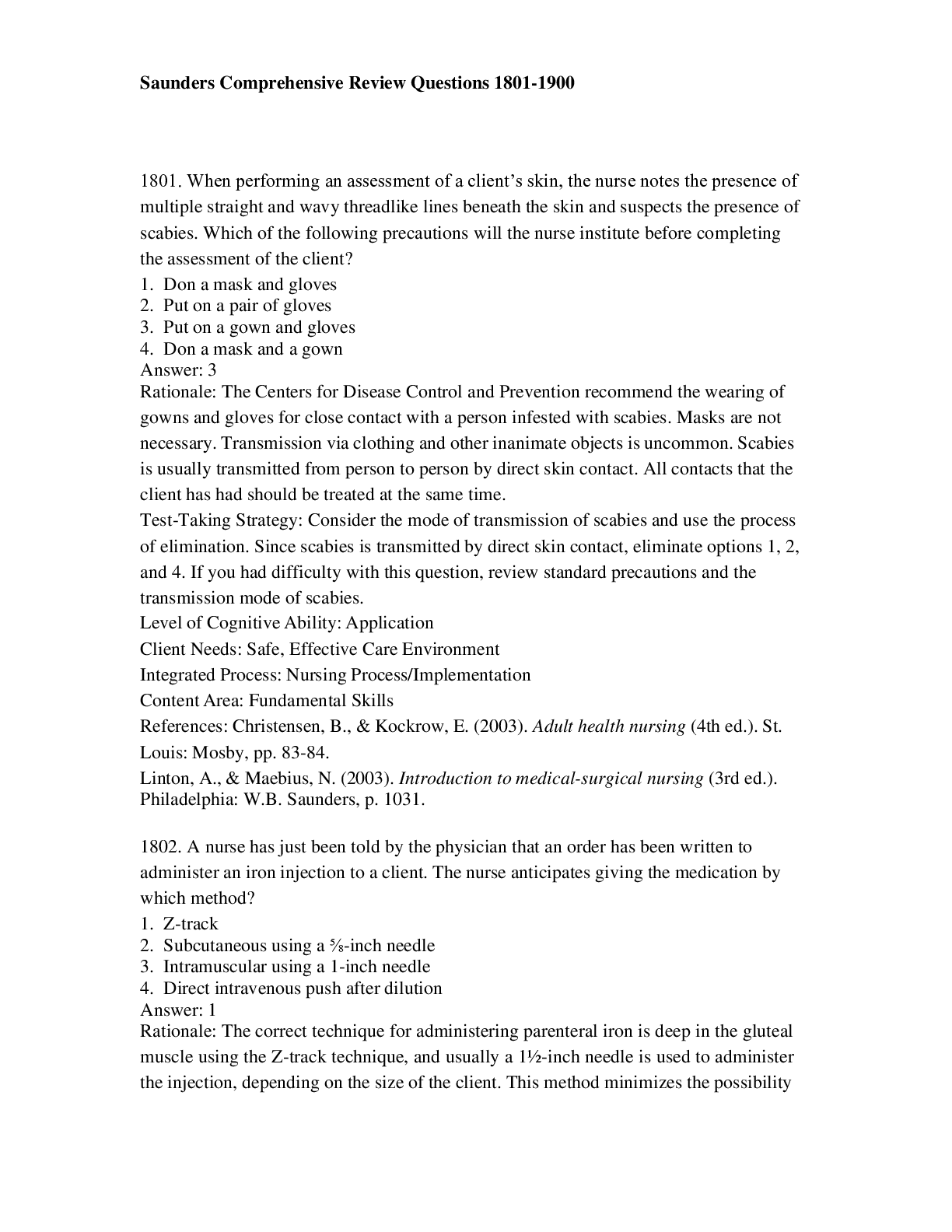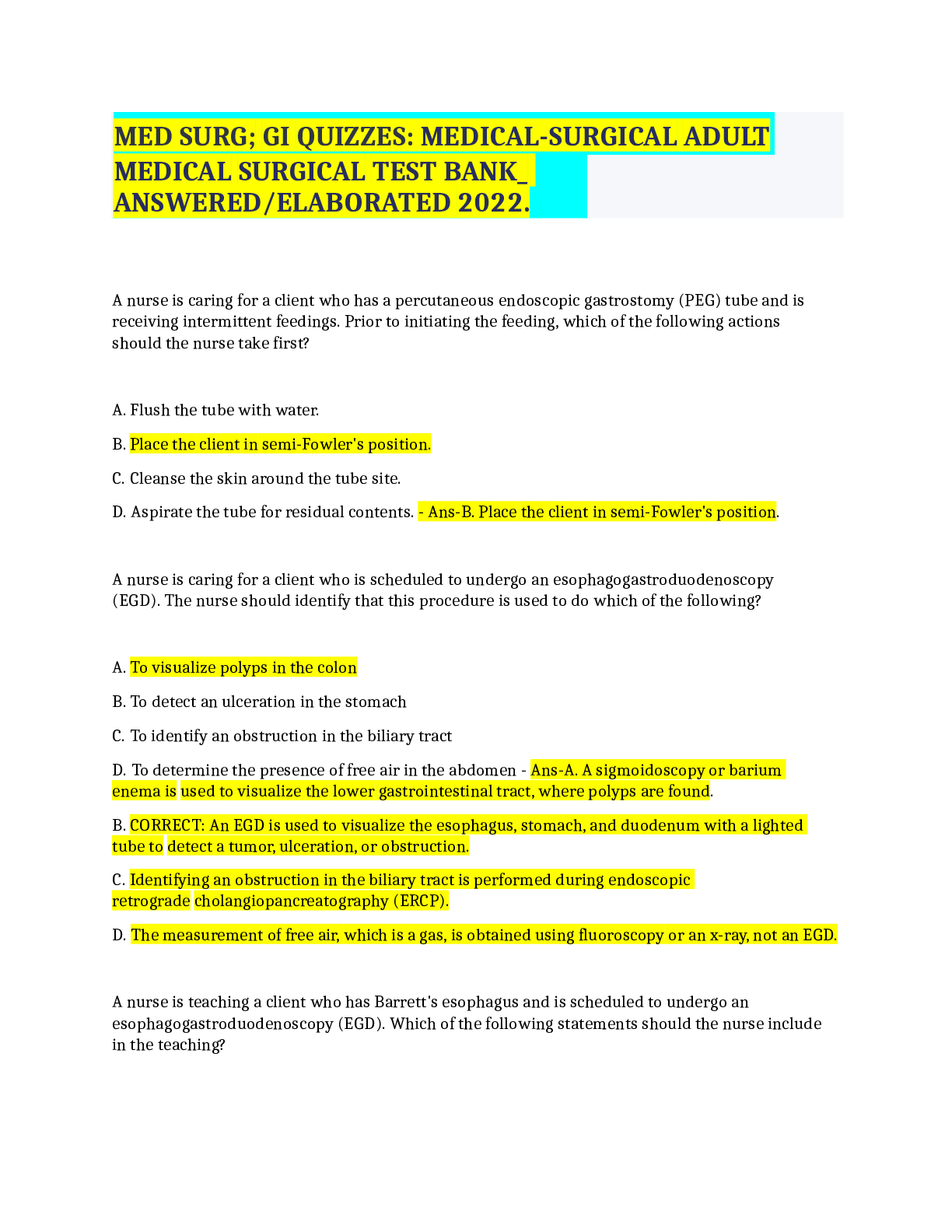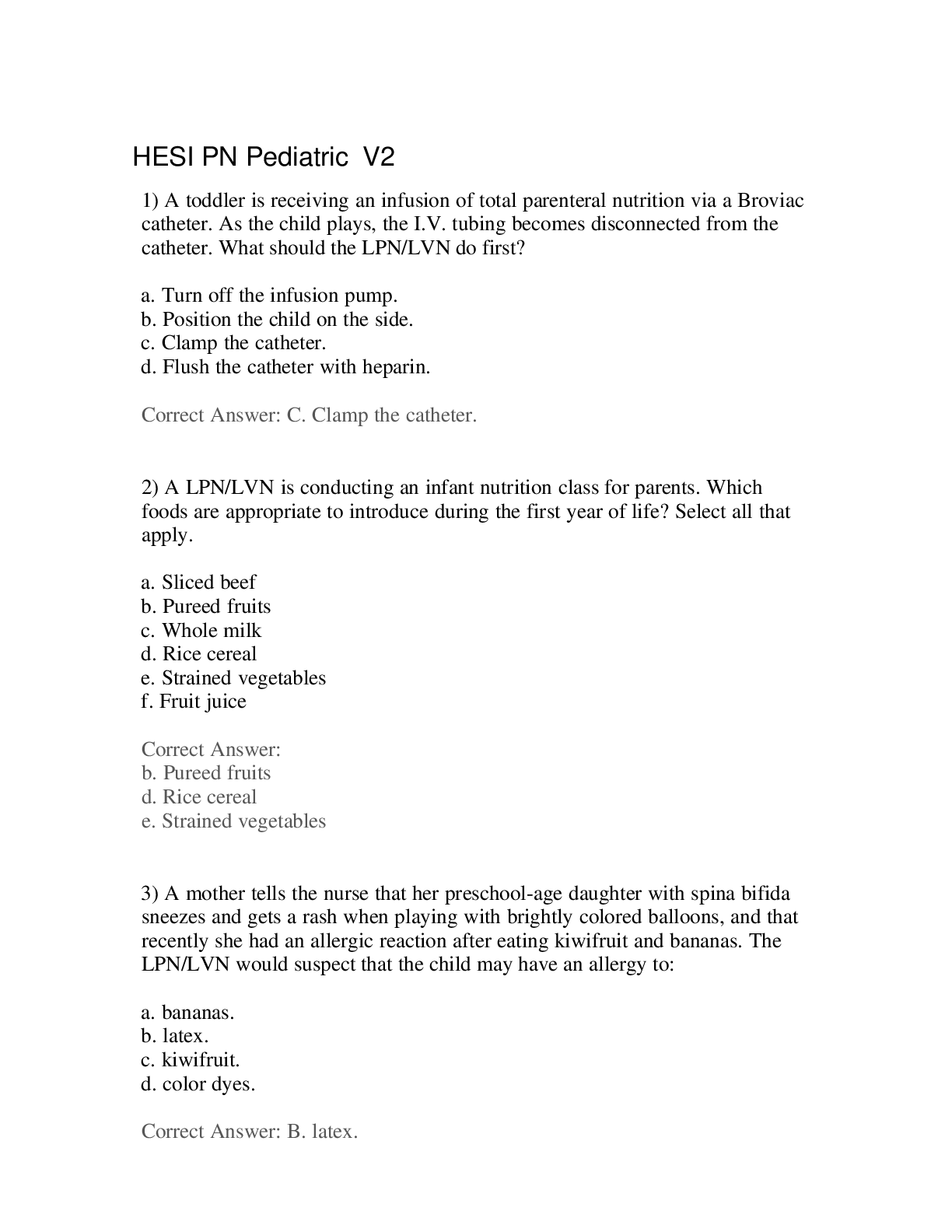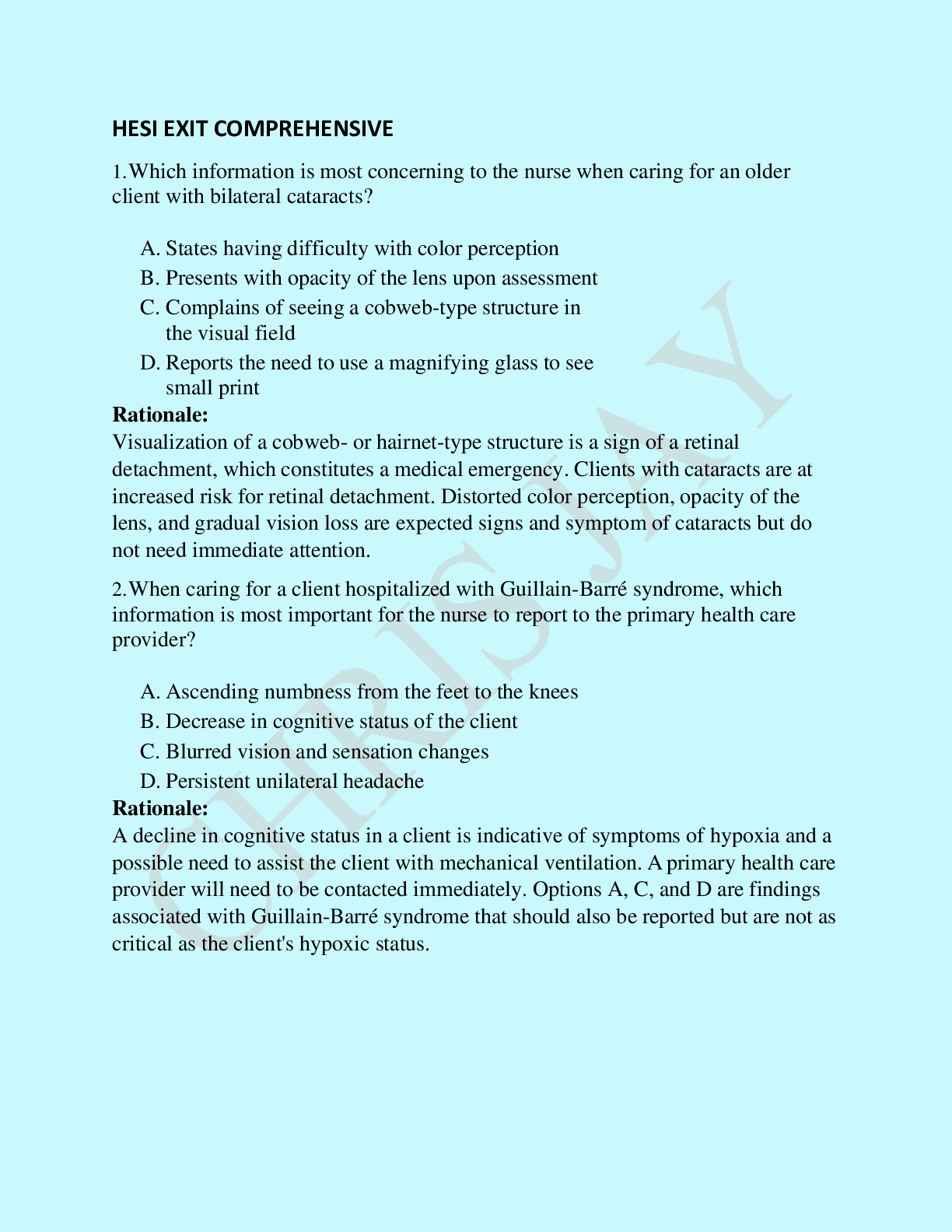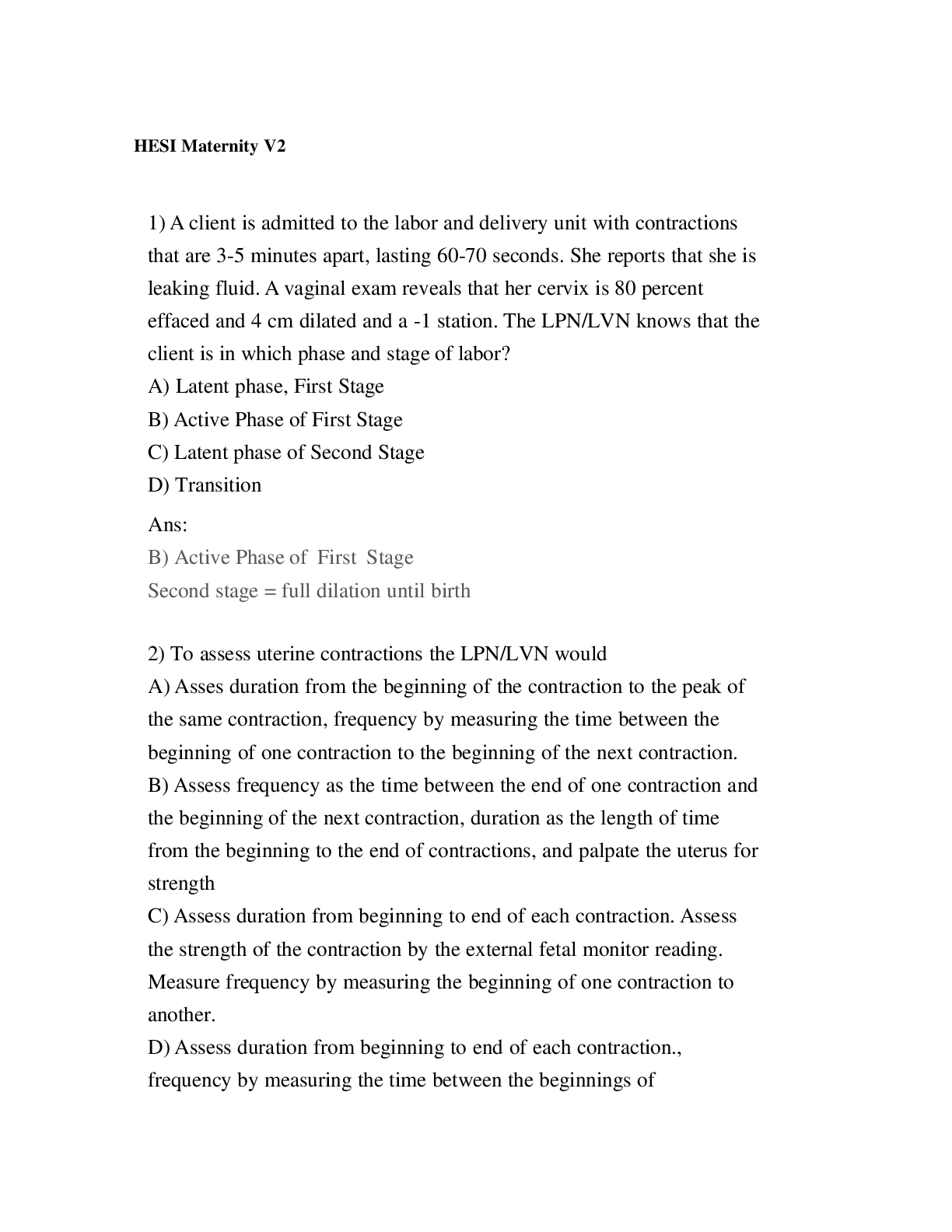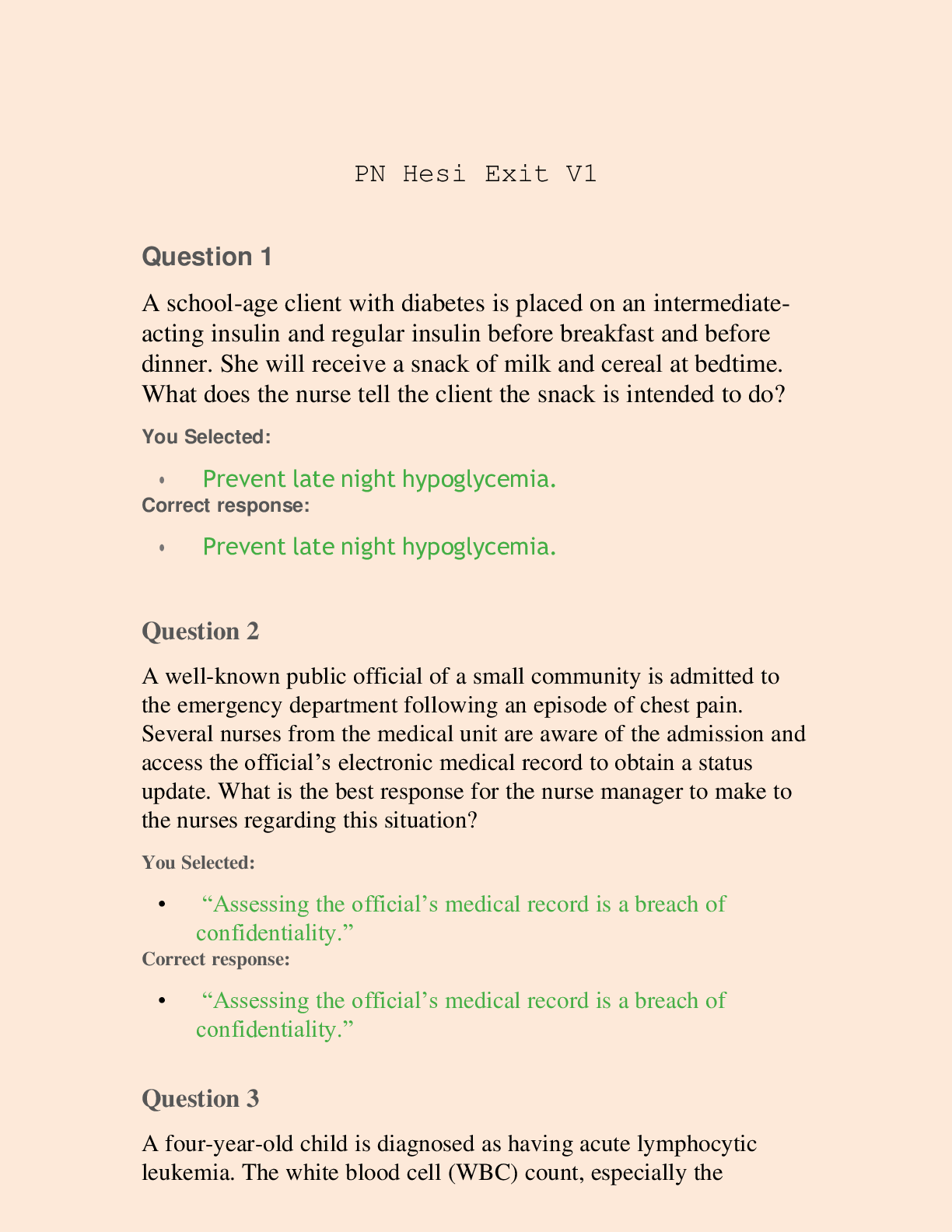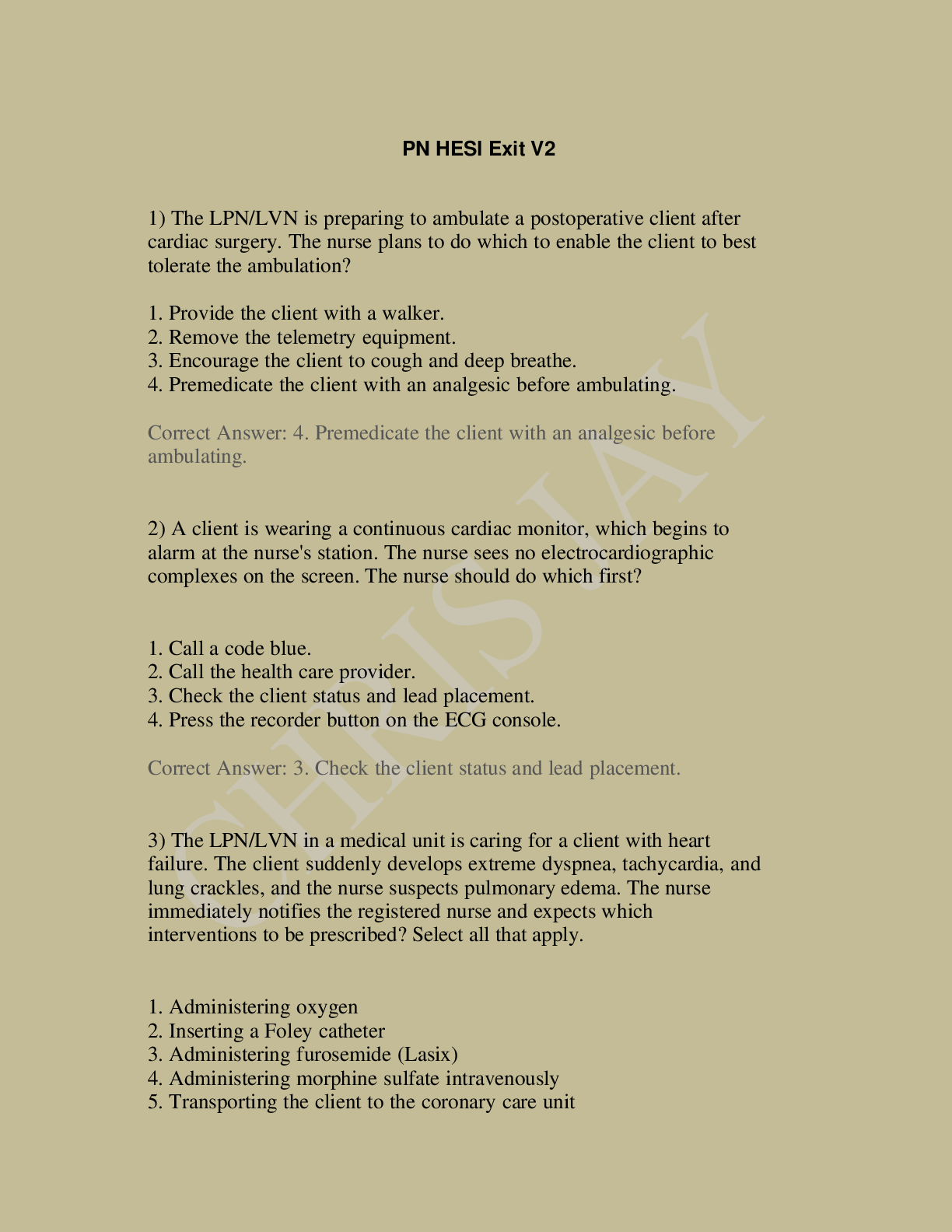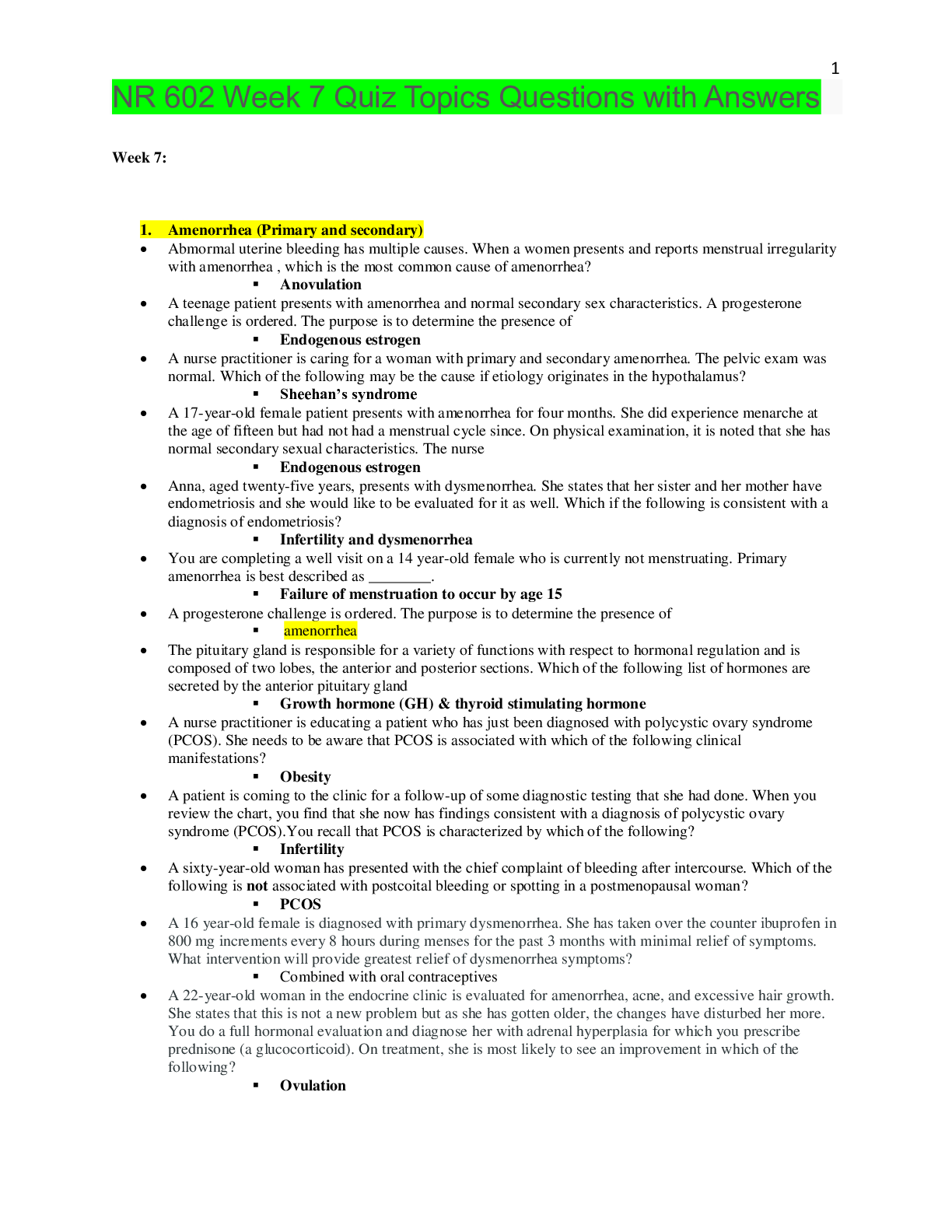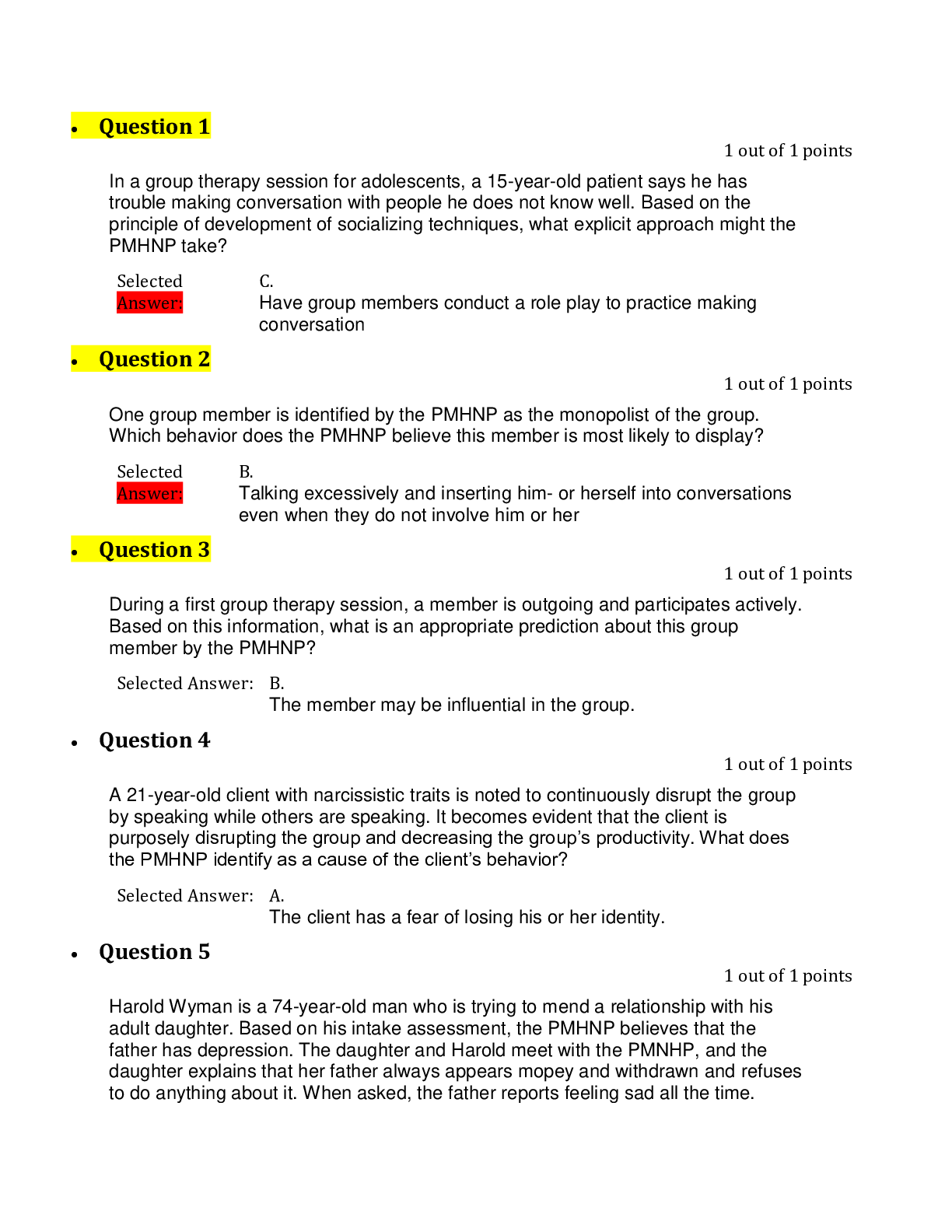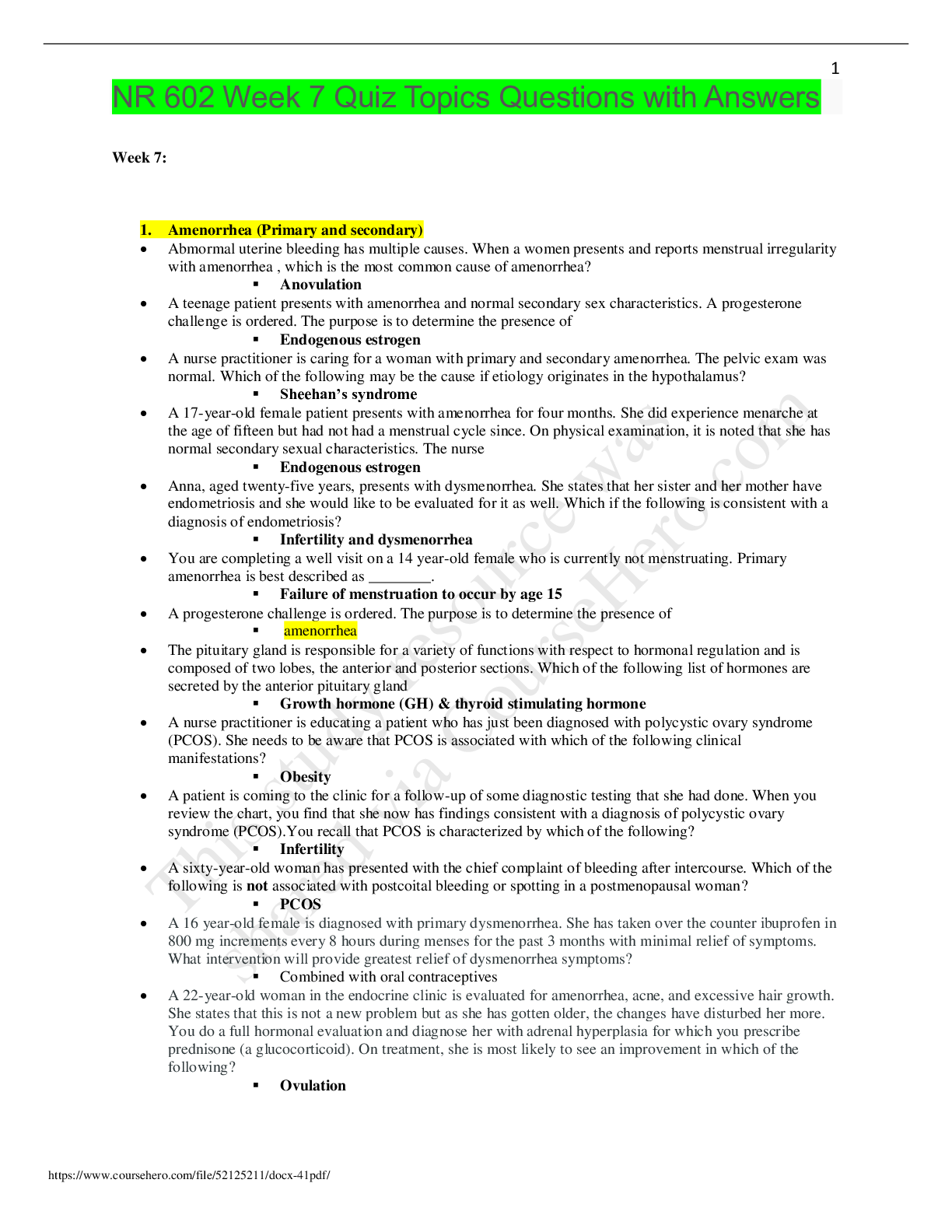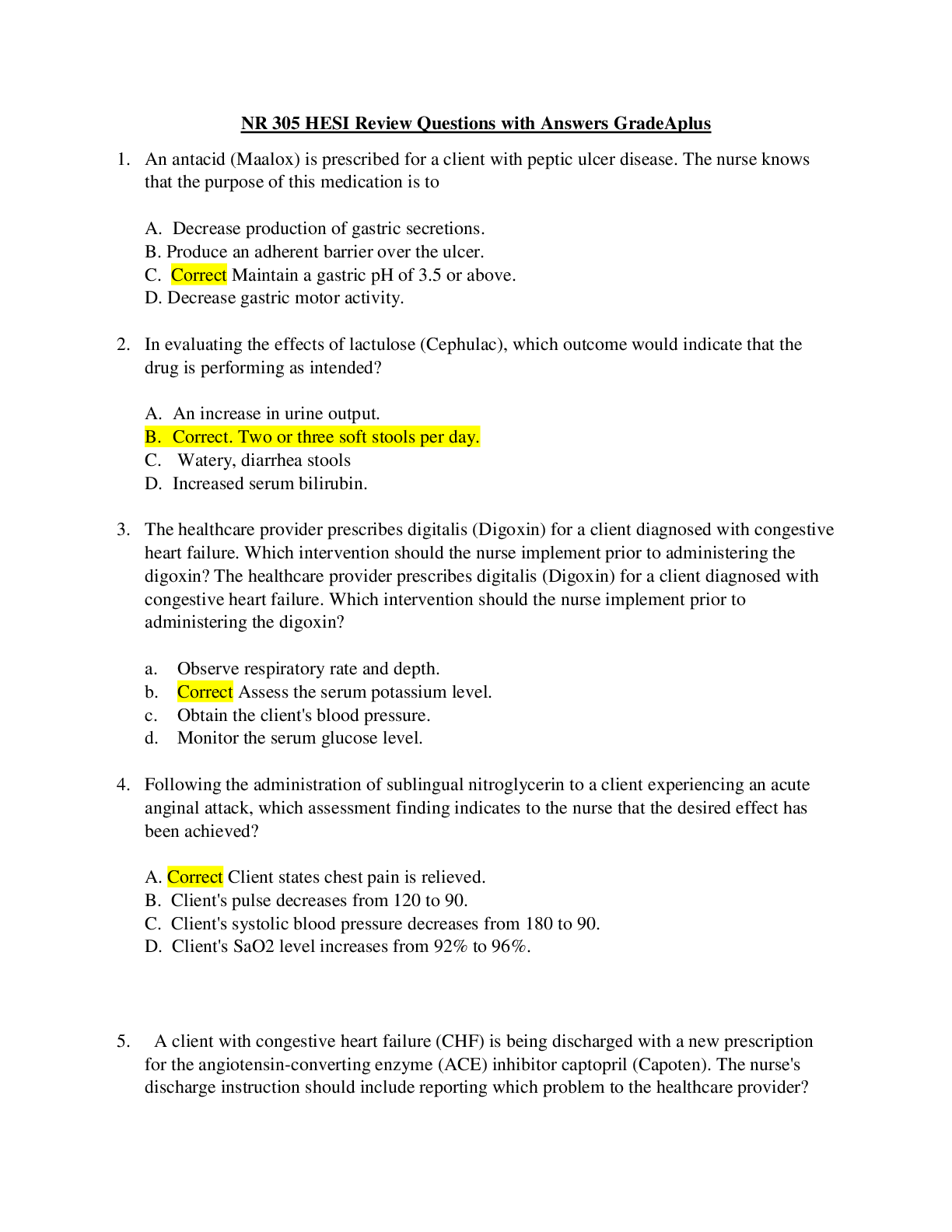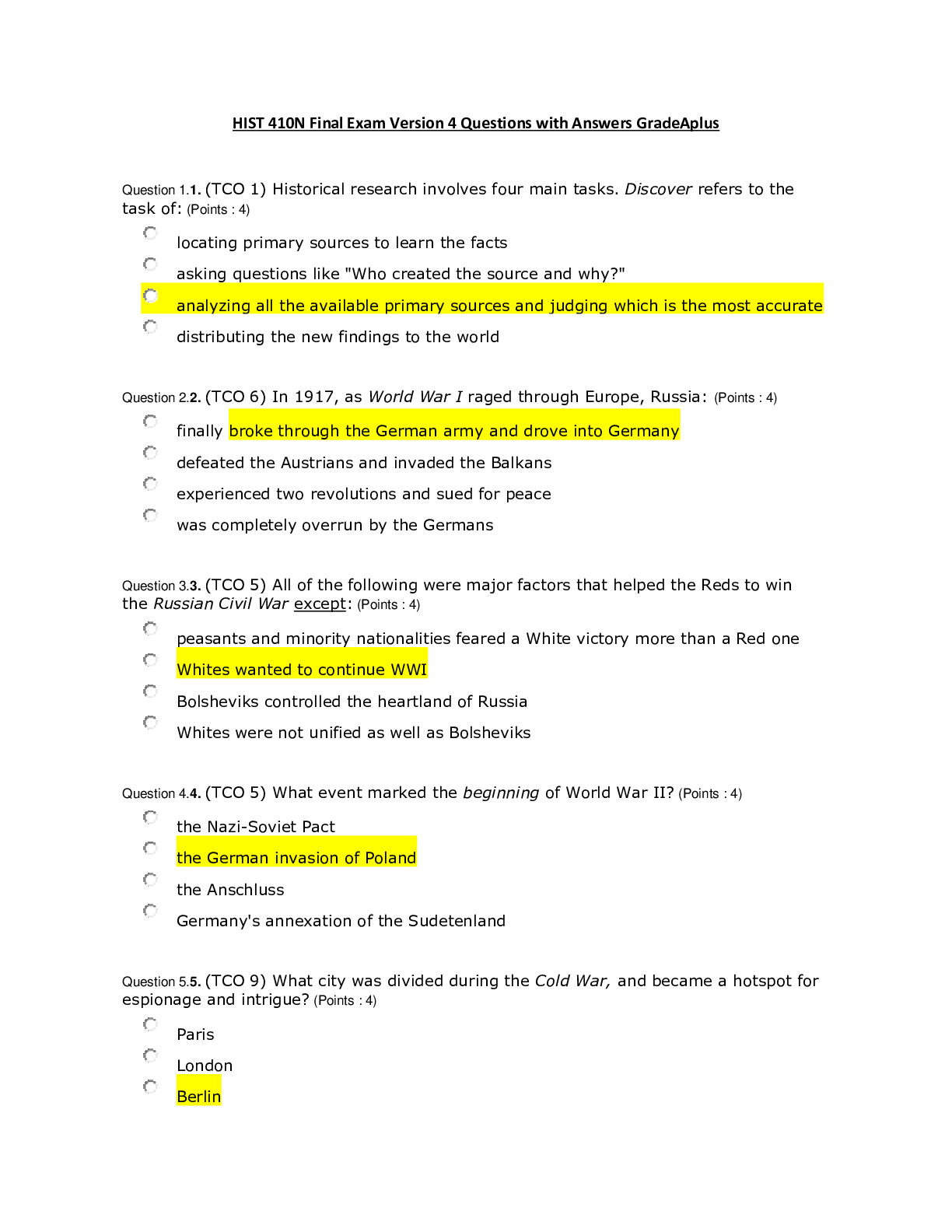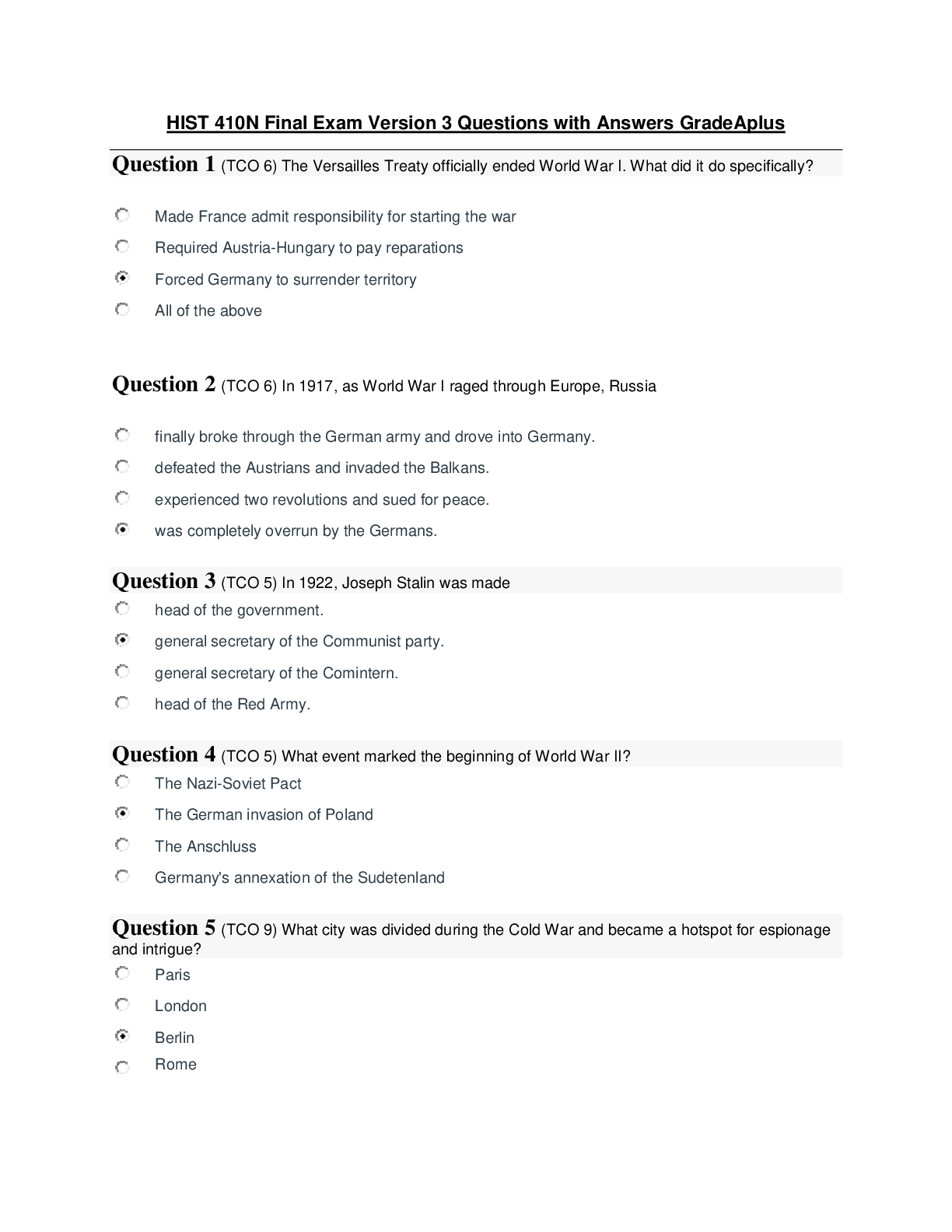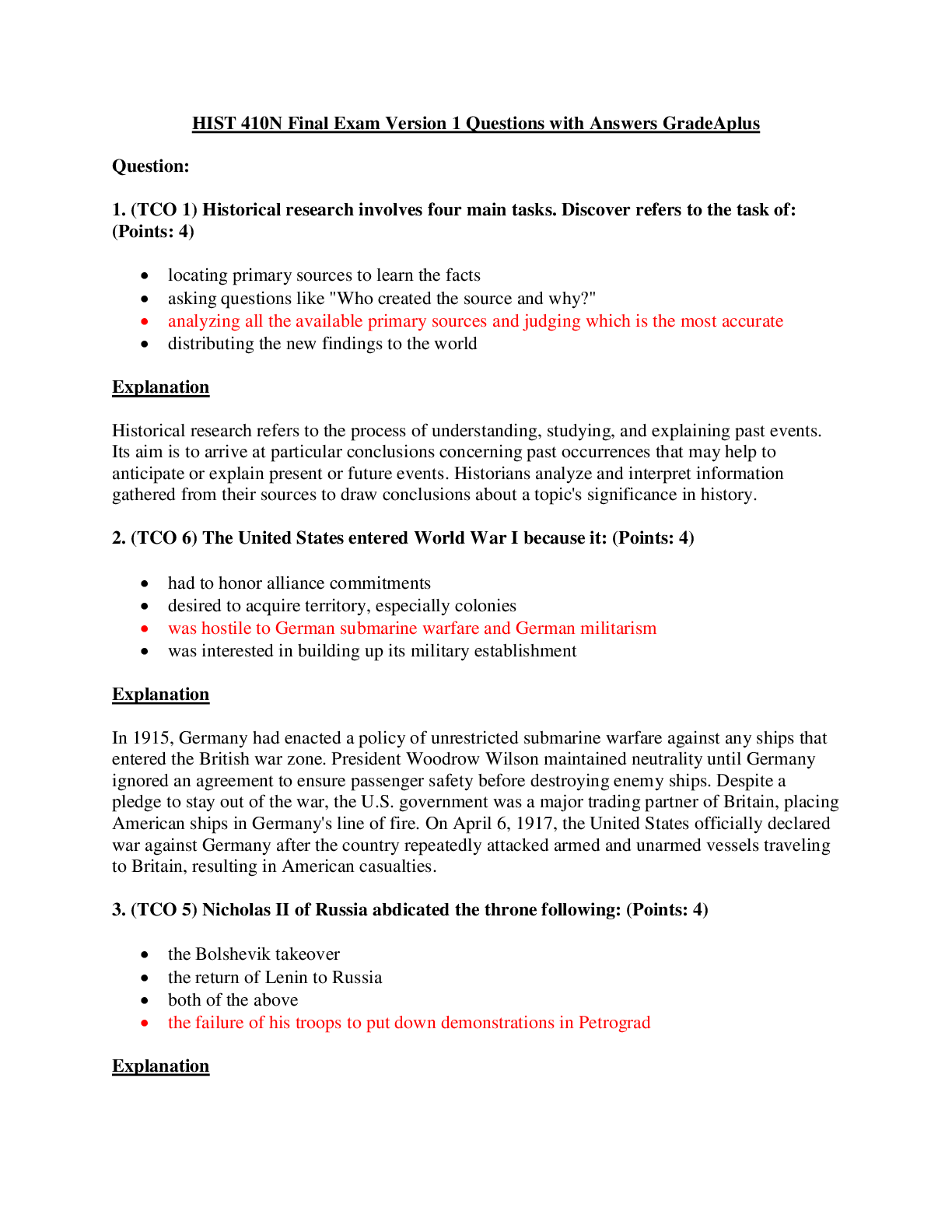Health Care > EXAM > NCLEX-PN 150 Questions with Answers and Rationale 2021 (All)
NCLEX-PN 150 Questions with Answers and Rationale 2021
Document Content and Description Below
An infant weighs 7 pounds at birth. The expected weight by 1 year should Be: A. 10 pounds B. 12 pounds C. 18 pounds D. 21 pounds Answer D: A birth weight of 7 pounds would indicate 21 pounds in 1... year, or triple his birth weight. Answers A, B, and C therefore are incorrect. 2. A client is admitted with a Ewing’s sarcoma. Which symptoms would be expected due to this tumor’s location? A. Hemiplegia B. Aphasia C. Nausea D. Bone pain Answer D: Sarcoma is a type of bone cancer; therefore, bone pain would be expected. Answers A, B, and C are not specific to this type of cancer and are incorrect. 3. A client arrives in the emergency room with a possible fractured femur. The nurse should anticipate an order for: A. Trendelenburg position B. Ice to the entire extremity C. Buck’s traction D. An abduction pillow Answer C: The client with a fractured femur will be placed in Buck’s traction to realign the leg and to decrease spasms and pain. The Trendelenburg position is the wrong position for this client, so answer A is incorrect. Ice might be ordered after repair, but not for the entire extremity, so answer B is incorrect. An abduction pillow is ordered after a total hip replacement, not for a fractured femur; therefore, answer D is incorrect. 4. Which action by the novice nurse indicates a need for further teaching? A. The nurse fails to wear gloves to remove a dressing. B. The nurse applies an oxygen saturation monitor to the ear lobe. C. The nurse elevates the head of the bed to check the blood pressure. D. The nurse places the extremity in a dependent position to acquire a peripheral blood sample. Answer A: The nurse who fails to wear gloves to remove a contaminated dressing needs further instruction. Answers B, C, and D are incorrect because they indicate an understanding of the correct method of completing these tasks. 5. The nurse is preparing a client for mammography. To prepare the client for a mammogram, the nurse should tell the client: A. To restrict her fat intake for 1 week before the test B. To omit creams, powders, or deodorants before the exam C. That mammography replaces the need for self-breast exams D. That mammography requires a higher dose of radiation than an x-ray Answer B: The client having a mammogram should be instructed to omit deodorants or powders beforehand because powders and deodorants can be interpreted as abnormal. Answer A is incorrect because there is no need for dietary restrictions before a mammogram. Answer C is incorrect because the mammogram does not replace the need for self-breast exams. Answer D is incorrect because a mammogram does not require higher doses of radiation than an x-ray. 6. The nurse employed in the emergency room is responsible for triage of four clients injured in a motor vehicle accident. Which of the following clients should receive priority in care? A. A 10-year-old with lacerations of the face B. A 15-year-old with sternal bruises C. A 34-year-old with a fractured femur D. A 50-year-old with dislocation of the elbow Answer B: The teenager with sternal bruising might be experiencing airway and oxygenation problems and, thus, should be seen first. In answer A, the 10-year-old with lacerations might look bad but is not in distress. The client in answer C with a fractured femur should be immobilized but can be seen after the client with sternal bruising. The client in answer D with the dislocated elbow can be seen later as well. 7. The client is receiving peritoneal dialysis. If the dialysate returns cloudy, the nurse should: A. Document the finding B. Send a specimen to the lab C. Strain the urine D. Obtain a complete blood count Answer B: If the dialysate returns cloudy, infection might be present and must be evaluated. Documenting the finding, as stated in answer A, is not enough; straining the urine, in answer C, is incorrect; and dialysate, in answer D, is not urine at all. However, the physician might order a white blood cell count. 8. The client with cirrhosis of the liver is receiving Lactulose. The nurse is aware that the rationale for the order for Lactulose is: A. To lower the blood glucose level B. To lower the uric acid level C. To lower the ammonia level D. To lower the creatinine level Answer C: Lactulose is administered to the client with cirrhosis to lower ammonia levels. Answers A, B, and D are incorrect because this does not have an effect on the other lab values. 9. The client with diabetes is preparing for discharge. During discharge teaching, the nurse assesses the client’s ability to care for himself. Which statement made by the client would indicate a need for follow-up after discharge? A. “I live by myself.” B. “I have trouble seeing.” C. “I have a cat in the house with me.” D. “I usually drive myself to the doctor.” Answer B: A client with diabetes who has trouble seeing would require follow-up after discharge. The lack of visual acuity for the client preparing and injecting insulin might require help. Answers A, C, and D will not prevent the client from being able to care for himself and, thus, are incorrect. 10. The client is receiving total parenteral nutrition (TPN). Which lab test should be evaluated while the client is receiving TPN? A. Hemoglobin B. Creatinine C. Blood glucose D. White blood cell count Answer C: When the client is receiving TPN, the blood glucose level should be drawn. TPN is a solution that contains large amounts of glucose. Answers A, B, and Dare not directly related to the question and are incorrect. 11. The nurse is making assignments for the day. Which client should be assigned to the nursing assistant? A. A client with Alzheimer’s disease B. A client with pneumonia C. A client with appendicitis D. A client with thrombophlebitis Answer A: The client with Alzheimer’s disease is the most stable of these clients and can be assigned to the nursing assistant, who can perform duties such as feeding and assisting the client with activities of daily living. The clients in answers B, C, and D are less stable and should be attended by a registered nurse. 12. A client with cancer develops xerostomia. The nurse can help alleviate the discomfort associated with xerostomia by: A. Offering hard candy B. Administering analgesic medications C. Splinting swollen joints D. Providing saliva substitute Answer D: Xerostomia is dry mouth, and offering the client a saliva substitute will help the most. Eating hard candy in answer a can further irritate the mucosa and cut the tongue and lips. Administering an analgesic might not be necessary; thus, answer B is incorrect. Splinting swollen joints, in answer C, is not associated with xerostomia. 13. A home health nurse is making preparations for morning visits. Which one of the following clients should the nurse visit first? A. A client with brain attack (stroke) with tube feedings B. A client with congestive heart failure complaining of nighttime dyspnea C. A client with a thoracotomy 6 months ago D. A client with Parkinson’s disease Answer B: The client with congestive heart failure who is complaining of nighttime dyspnea should be seen first because airway is number one in nursing care. In answers A, C, and D, the clients are more stable. 14. A client with glomerulonephritis is placed on a low-sodium diet. Which of the following snacks is suitable for the client with sodium restriction? A. Peanut butter cookies B. Grilled cheese sandwich C. Cottage cheese and fruit D. Fresh peach Answer D: The fresh peach is the lowest in sodium of these choices. Answers A, B, and C have much higher amounts of sodium. 15. The nurse has just received a change-of-shift report. Which client should the nurse assess first? A. A client 2 hours post-lobectomy with 150ccs drainage B. A client 2 days post-gastrectomy with scant drainage C. A client with pneumonia with an oral temperature of 102°F D. A client with a fractured hip in Buck’s traction Answer A: The first client to be seen is the one who recently returned from surgery. The other clients in answers B, C, and D are more stable and can be seen later. 16. Several clients are admitted to the emergency room following a three-car vehicle accident. Which clients can be assigned to share a room in the emergency department during the disaster? A. The schizophrenic client having visual and auditory hallucinations and the client with ulcerative colitis B. The client who is 6 months pregnant with abdominal pain and the client with facial lacerations and a broken arm C. A child whose pupils are fixed and dilated and his parents, and the client with a frontal head injury D. The client who arrives with a large puncture wound to the abdomen and the client with chest pain Answer B: Out of all of these clients, it is best to hold the pregnant client and the client with a broken arm and facial lacerations in the same room. The clients in answer a need to be placed in separate rooms because these clients are disruptive or have infections. In the case of answer C, the child is terminal and should be in a private room with his parents. 17. The nurse is planning room assignments for the day. Which client should be assigned to a private room if only one is available? A. The client with Cushing’s disease B. The client with diabetes C. The client with acromegaly D. The client with myxedema Answer A: The client with Cushing’s disease has adrenocortical hypersecretion. This increase in the level of cortisone causes the client to be immune suppressed. In answer B, the client with diabetes poses no risk to other clients. The client in answer C has an increase in growth hormone and poses no risk to himself or others. The client in answer D has hyperthyroidism or myxedema, and poses no risk to others or himself. 18. The nurse is making assignments for the day. Which client should be assigned to the pregnant nurse? A. The client receiving linear accelerator radiation therapy for lung cancer B. The client with a radium implant for cervical cancer C. The client who has just been administered soluble brachytherapy for thyroid cancer D. The client who returned from placement of iridium seeds for prostate cancer Answer A: The pregnant nurse should not be assigned to any client with radioactivity present. Therefore, the client receiving linear accelerator therapy is correct because this client travels to the radium department for therapy, and the radiation stays in the department; the client is not radioactive. The client in answer B does pose a risk to the pregnant client. The client in answer C is radioactive in very small doses. For approximately 72 hours, the client should dispose of urine and feces in special containers and use plastic spoons and forks. The client in answer D is also radioactive in small amounts, especially upon return from the procedure. 19. The client is receiving heparin for thrombophlebitis of the left lower extremity. Which of the following drugs reverses the effects of heparin? A. Cyanocobalamin B. Protamine sulfate C. Streptokinase D. Sodium warfarin Answer B: The antidote for heparin is protamine sulfate. Cyanocobalamin is B12, Streptokinase is a thrombolytic, and sodium warfarin is an anticoagulant. Therefore, answers A, C, and D are incorrect. 20. The client is admitted with a BP of 210/120. Her doctor orders furosemide (Lasix) 40mg IV stat. How should the nurse administer the prescribed furosemide to this client? A. By giving it over 1–2 minutes B. By hanging it IV piggyback C. With normal saline only D. By administering it through a venous access device Answer A: Lasix should be given approximately 1mL per minute to prevent hypotension. Answers B, C, and D are incorrect because it is not necessary to be given in an IV piggyback, with saline, or through a venous access device (VAD). [Show More]
Last updated: 1 year ago
Preview 1 out of 80 pages
Instant download
Buy this document to get the full access instantly
Instant Download Access after purchase
Add to cartInstant download
Reviews( 0 )
Document information
Connected school, study & course
About the document
Uploaded On
Aug 12, 2021
Number of pages
80
Written in
Additional information
This document has been written for:
Uploaded
Aug 12, 2021
Downloads
0
Views
38



